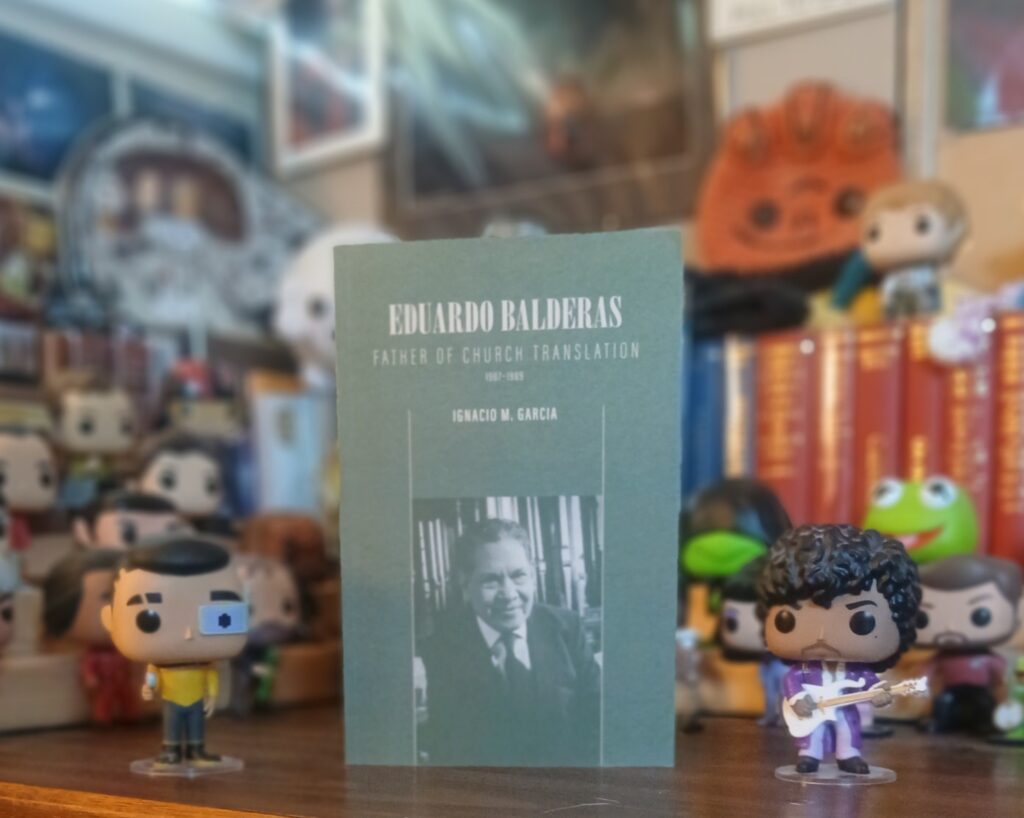Review
======
Title: Eduardo Balderas: Father of Church Translation, 1907-1989
Author: Ignacio M. Garcia
Publisher: Signature Books
Genre: Biography
Year Published: 2024
Number of Pages: 231
Binding: Paperback
ISBN: 9781560855170
Price: $18.95
Reviewed by Jessie Christensen for the Association of Mormon Letters
Towards the end of his new biography of Eduardo Balderas, author Ignacio Garcia includes an anecdote related by Gordon B. Hinckley. Two young men approached the information booth on Temple Square shortly after a general conference and asked where they could find Eduardo Balderas. The volunteer in the booth had no idea who they were asking about, and the men were astonished because they thought everyone in the LDS Church knew Eduardo. For several decades in the mid-twentieth century, everyone in the Spanish-speaking Church did know Eduardo. Balderas was the first translator employed by the Church; he translated into Spanish the Doctrine & Covenants and Pearl of Great Price, text for temple ordinances, the hymnbook, magazines and lesson manuals, and a number of books. He also served as an interpreter for General Authorities when they traveled to Latin America and for general conference broadcasts.
Eduardo Balderas was born in Mexico and raised in El Paso, Texas after his parents moved to the United States when he was a young child. His parents joined the Church in El Paso and became very active in their branch, although Eduardo described himself as not very active in the church as a teenager. He had little formal education in either English or Spanish, but his bilingual upbringing led him to work as a translator at a movie theater while he was still in high school. Later, during his service as a missionary and afterward, Eduardo became friends with first Rey Pratt and later Antoine R. Ivins, who served as president of the Mexican Mission (headquartered in the United States for many years). After Ivins returned to Salt Lake and was appointed as a Seventy, he advocated for the creation of a Church department that would centralize translation for Church materials and suggested Eduardo as its first hire. In 1939, Eduardo moved to Salt Lake City and began working for the Church in a job he would continue to do for nearly fifty years.
As Garcia mentions in his introduction and the notes to this biography, sources about the life of Eduardo Balderas are limited. He did not leave behind a journal or any personal papers. The main sources Garcia draws on are oral history interviews recorded at Church headquarters and conversations with some members of the Balderas family. However, he draws on other scholarship to place Balderas and his life in the context of Mexican American history and Mormon history of the twentieth century. The decades in which Balderas lived and worked were times of great change for both the Chicano movement and for the international growth of the Church. One of the strengths of the book is the way Garcia weaves together the story of Balderas with the times in which he lived, showing how he was both a product of his time and also stood apart from it in some ways.
The work of translation takes place in interstitial spaces. Translators work between languages and cultures and are often unseen and unacknowledged. Eduardo Balderas embodied this reality in many ways: he was a Brown man in a White church, particularly after moving to Salt Lake City and working at church headquarters; he moved between Mexican and American cultural spaces; he worked for years at church headquarters with numerous general authorities and yet never held any major church calling until he was called as a patriarch; he was the first employee of what would later become the Translation Department, yet never asked to lead it; his work was vital in spreading the gospel to thousands of members of the Church, yet most members know nothing about him. This book is not only a well-written tribute to an underappreciated historical figure but also a valuable addition to the growing scholarly body of work about the global history of the Church. It should also be consulted by anyone studying LDS book history, the history of translation within the church, the publication and distribution of scriptures and hymnbooks, and the evolution of temple ordinances. Although this is an excellent book and a comprehensive look at the life of a relatively unknown powerhouse in Church history, I hope it is not the last word on Eduardo Balderas or the significance of his life and work.

